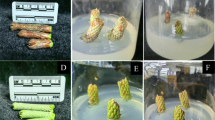Abstract
A micropropagation protocol for Psiadia arguta, an endangered endemic plant from Mauritius is described using 15-day old in vitro seedling explants without the radicle. MS basal medium supplemented with TDZ (0.5–1 mg/l) proved to be the most effective medium for the induction of cotyledonary axillary buds as compared to MS medium containing NAA (0.5 mg/l) or both NAA (0.5 mg/l) and TDZ (0.5–1 mg/l). In fact, after transfer to hormone free MS medium, microshoots were obtained only from seedling explants cultured on media containing only TDZ. Regenerated shoots elongated and rooted when cultured on MS8900 containing IBA (0–1 mg/l). Hormone-free MS8900 was the best medium for rooting and development of plantlets for acclimatization.
Similar content being viewed by others
References
Bon MC and Monteuuis O (1996) Biotechnologies forestières au Sabah. Premier bilan. Bois et ForĶts des Tropiques 248: 31-41
Diallo N and Duhoux E (1984) Organogenèse et multiplication in vitro chez l'Eucalyptus camaldulensis. J Plant Physiol 115: 177-182
Duhoux E and Davies D (1985) Callogenèse à partir de bourgeons cotylédonaires de L'Acacia albida et influence du saccharose sur la rhyzogenèse. J Plant Physiol 121: 175-180
Duhoux E (1988) Organogenèse et multiplication végétative chez les arbres. In: Zryd JP (ed) Cultures de Cellules, Tissus et Organes Végétaux, pp 59-67. Lausanne: Presses Polytechniques Romandes
Galiana A (1991) La symbiose fixatrice d'azote chez Acacia mangiumRhiziobium. Thèse de 3 ème cycle. Université de Paris VI, France, 264 p
GuribFakim A, Guého J and Bissoondoyal MD (1996) Plantes médicinales de Maurice. Tome 1. Editions de l'Océan Indien
Huetteeman CA and Preece JE (1993) Thidiazuron: A potent cytokinin for woody plant tissue culture. Plant Cell Tiss Org Cult 33: 105-119
Margara J (1980) La culture de méristème et d'apex de tige. In: La multiplication végétative des végétaux supérieurs, pp 115- 131. Paris: GauthierVillars
Murashige T and Skoog F (1962) A revised medium for rapid growth and bioassays with tobacco tissue cultures. Physiol Plant 15: 473-479
Nandwani D and Ramawat KG(1962) High frequency plantlets regeneration from seedling explants of Prosopsis tamarugo. Plant Cell Tiss Org Cult 29: 173-178
Sanago MHM, Murch SJ, Slimon TY, Krishnaraj S and Saxena PK (1995) Morphoregulatory role of thidiazuron: Morphogenesis of root growth in thidiazurontreated geranium. Plant Cell Reports
Sanago MHM, Shattuck VI and Strommer J (1996) Rapid plant regeneration of pea using thidiazuron. Plant Cell Tiss Org Cult 45: 165-168
Sokal RR and Rohlf RFJ (1981) Biometry, 2nd. ed. New York: WH Freeman
Author information
Authors and Affiliations
Rights and permissions
About this article
Cite this article
Kodja, H., Robene-Soustrade, I., Humeau, L. et al. Micropropagation of Psiadia arguta through cotyledonary axillary bud culture. Plant Growth Regulation 25, 75–80 (1998). https://doi.org/10.1023/A:1005913116300
Issue Date:
DOI: https://doi.org/10.1023/A:1005913116300




